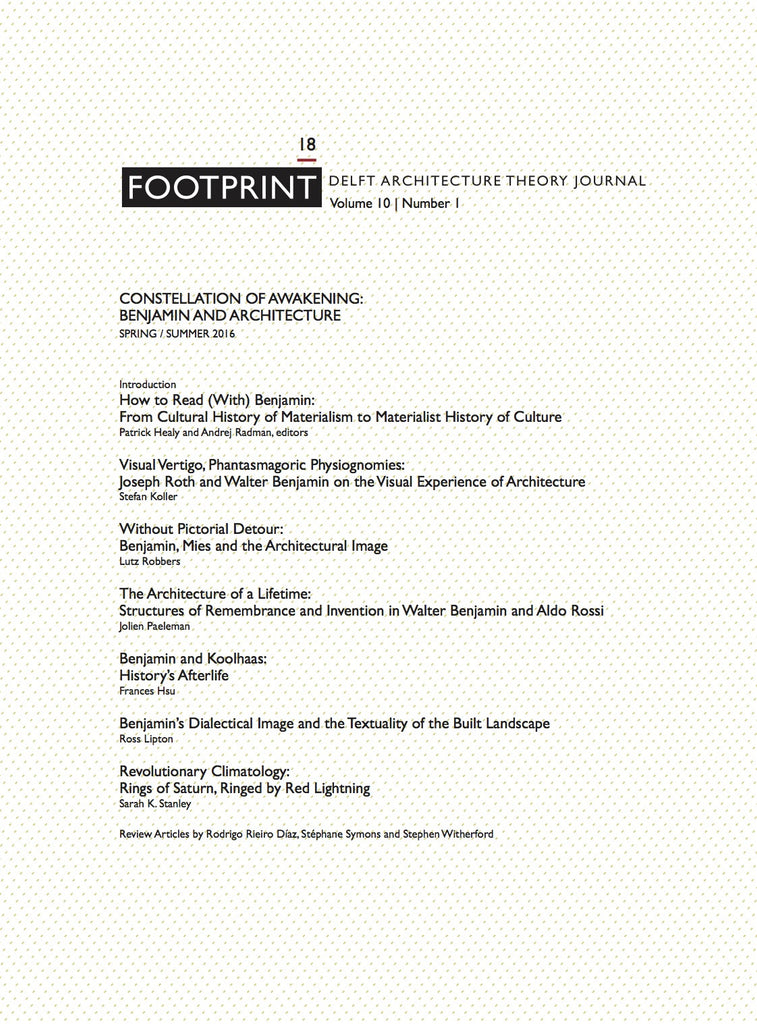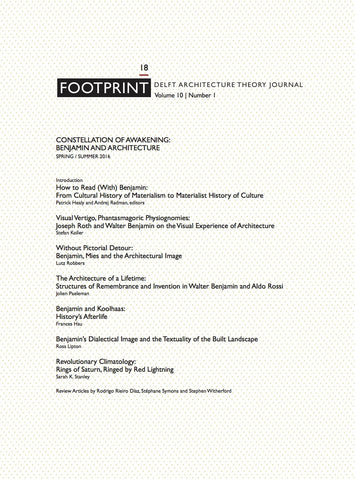Your cart is currently empty!
Footprint 18 Vol 10/1 Constellation of Awakening: Benjamin and Architecture
+++ +++
+++Patrick Healy, Andrej Radman [red.]+++
978-94-90322-64-9
Meagan Kerr
144
19 x 25.7 cm
paperback
Verschijningsdatum: Voorjaar/Zomer 2016
Engels
Copy editor: Heleen Schröder
Uitgegeven in samenwerking met Architecture Theory Chair (TU Delft) en Stichting Footprint: http://footprint.tudelft.nl/
Voor een abonnement op Footprint: Bruil & Van de Staaij
Met bijdragen van
Patrick Healy, Andrej Radman (introduction), Stefan Koller, Lutz Robbers, Jolien Paeleman, Frances Hsu, Ross Lipton, Sarah K. Stanley, Rodrigo Rieiro Díaz, Stéphane Symons, Stephen Michael Witherford
In Das Passagen-Werk Benjamin cites a letter from Marx to Ruge, 'the reform of consciousness consists solely in [...] the awakening of the world from its dream about itself.' This idea of awakening recurs in Benjamin's methodological considerations and his many metaphors during the final thirteen years of his life. Benjamin set himself the pedagogical task of awakening 'the image-making medium within us, raising it to a stereoscopic and dimensional seeing into the depths of historical shadows.' His ambition was to develop the art of citing without quotation marks, a concept intimately related to that of montage.
The importance of architectural theory for Benjamin is most evident in his last work. From his writings on Berlin childhood, his essay on Moscow and Naples, Benjamin's interest in urban topography can be seen to develop into a full analysis of the city, by developing a method which he refers to as physiognomic and in which, inspired by contemporary surrealist practise, the method of montage becomes critical for his showing how the 'now of recognition' in the image opens the historical to awareness, and constitutes the reality of history. He cites Giedion and sees his own work as engaged in a similar task: 'just as Giedion teaches us to read off the basic features of today's architecture in the buildings erected around 1850,' Benjamin writes, 'we in turn would recognise today's forms, in the life and in the apparently secondary lost forms of that epoch.'
It was a matter of immediate concern for Benjamin to examine the secondary, the excluded. By a displacement of the angle of vision a positive element would emerge, something different from that previously signified. History is in the nuance, the dialectical contrast as revealed in Benjamin's Parisian studies of the expressive character of the earliest industrial architecture, machines, department stores and advertisements. Nevertheless, as is clear from his note of the comment from Max Raphael's Proudhon, Marx, Picasso, Benjamin reproaches Marx for not having advanced along this way in the full measure of the possibilities of historical materialism.
Footprint 18 investigates the following issues: what Benjamin understands by the 'constellation of awakening', how he conceptualises 'dialectical images', his deployment of montage, his refusal of a conception of either progress or decline, and his undertaking to show that the images belong not only to a particular time but attain legibility only at a particular time. Famously, according to Benjamin, image is that wherein what has been comes together in a flash with the now to form a constellation. With regard to the architectural theory Benjamin engaged directly with the tectonic tradition, especially the work of Bötticher. He posited the tectonic unconscious and the deployment of optical instruments as crucial for understanding the development which architecture carried from the luxus capitalist forms of commodity. In light of technical innovations in iron and glass, it expressed a form of projective dream work of the architectural around material realisations as products of the industrial revolution, with long consequences for the future.
Footprint is an academic journal dedicated to publishing architecture and urban research. Architecture and urbanism are the points of departure and the core interests of the journal. From this perspective, the journal encourages the study of architecture and the urban environment as a means of comprehending culture and society, and as a tool for relating them to shifting ideological doctrines and philosophical ideas. The journal promotes the creation and development – or revision - of conceptual frameworks and methods of inquiry. It is engaged in creating a body of critical and reflexive texts with a breadth and depth of thought which would enrich the architecture discipline and produce new knowledge, conceptual methodologies and original understandings.
€25.00
Footprint 18 Vol 10/1 Constellation of Awakening: Benjamin and Architecture
€25.00
Architectuur / Bookazines / serie / Theorie
978-94-90322-64-9
Meagan Kerr
144
19 x 25.7 cm
paperback
Verschijningsdatum: Voorjaar/Zomer 2016
Engels
Copy editor: Heleen Schröder
Uitgegeven in samenwerking met Architecture Theory Chair (TU Delft) en Stichting Footprint: http://footprint.tudelft.nl/
Voor een abonnement op Footprint: Bruil & Van de Staaij
Met bijdragen van
Patrick Healy, Andrej Radman (introduction), Stefan Koller, Lutz Robbers, Jolien Paeleman, Frances Hsu, Ross Lipton, Sarah K. Stanley, Rodrigo Rieiro Díaz, Stéphane Symons, Stephen Michael Witherford
In Das Passagen-Werk Benjamin cites a letter from Marx to Ruge, 'the reform of consciousness consists solely in [...] the awakening of the world from its dream about itself.' This idea of awakening recurs in Benjamin's methodological considerations and his many metaphors during the final thirteen years of his life. Benjamin set himself the pedagogical task of awakening 'the image-making medium within us, raising it to a stereoscopic and dimensional seeing into the depths of historical shadows.' His ambition was to develop the art of citing without quotation marks, a concept intimately related to that of montage.
The importance of architectural theory for Benjamin is most evident in his last work. From his writings on Berlin childhood, his essay on Moscow and Naples, Benjamin's interest in urban topography can be seen to develop into a full analysis of the city, by developing a method which he refers to as physiognomic and in which, inspired by contemporary surrealist practise, the method of montage becomes critical for his showing how the 'now of recognition' in the image opens the historical to awareness, and constitutes the reality of history. He cites Giedion and sees his own work as engaged in a similar task: 'just as Giedion teaches us to read off the basic features of today's architecture in the buildings erected around 1850,' Benjamin writes, 'we in turn would recognise today's forms, in the life and in the apparently secondary lost forms of that epoch.'
It was a matter of immediate concern for Benjamin to examine the secondary, the excluded. By a displacement of the angle of vision a positive element would emerge, something different from that previously signified. History is in the nuance, the dialectical contrast as revealed in Benjamin's Parisian studies of the expressive character of the earliest industrial architecture, machines, department stores and advertisements. Nevertheless, as is clear from his note of the comment from Max Raphael's Proudhon, Marx, Picasso, Benjamin reproaches Marx for not having advanced along this way in the full measure of the possibilities of historical materialism.
Footprint 18 investigates the following issues: what Benjamin understands by the 'constellation of awakening', how he conceptualises 'dialectical images', his deployment of montage, his refusal of a conception of either progress or decline, and his undertaking to show that the images belong not only to a particular time but attain legibility only at a particular time. Famously, according to Benjamin, image is that wherein what has been comes together in a flash with the now to form a constellation. With regard to the architectural theory Benjamin engaged directly with the tectonic tradition, especially the work of Bötticher. He posited the tectonic unconscious and the deployment of optical instruments as crucial for understanding the development which architecture carried from the luxus capitalist forms of commodity. In light of technical innovations in iron and glass, it expressed a form of projective dream work of the architectural around material realisations as products of the industrial revolution, with long consequences for the future.
Footprint is an academic journal dedicated to publishing architecture and urban research. Architecture and urbanism are the points of departure and the core interests of the journal. From this perspective, the journal encourages the study of architecture and the urban environment as a means of comprehending culture and society, and as a tool for relating them to shifting ideological doctrines and philosophical ideas. The journal promotes the creation and development – or revision - of conceptual frameworks and methods of inquiry. It is engaged in creating a body of critical and reflexive texts with a breadth and depth of thought which would enrich the architecture discipline and produce new knowledge, conceptual methodologies and original understandings.



